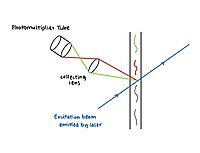
Photo from wikipedia
Men affected with idiopathic infertility often display basic spermiogramme values similar to fertile individuals, questioning the diagnostic impact of the World Health Organization (WHO) thresholds used. This study explored sperm… Click to show full abstract
Men affected with idiopathic infertility often display basic spermiogramme values similar to fertile individuals, questioning the diagnostic impact of the World Health Organization (WHO) thresholds used. This study explored sperm DNA fragmentation in single ejaculates from 14 fertile donors and 42 patients with idiopathic infertility providing semen for assisted reproductive techniques in a university fertility clinic. Each ejaculate was simultaneously studied for sperm DNA fragmentation by the flow cytometer‐based sperm chromatin structure analysis (SCSA) and the new light‐microscopy‐based sperm chromatin dispersion assay (SCD‐HaloSpermG2®), before and after sperm selection for in vitro fertilisation with a colloid discontinuous gradient. The WHO semen variables did not differ between groups, but DNA fragmentation after SCSA (DFI) or SCD (SDF) was significantly (p < 0.05) higher in patients (DFI: 40.2% ± 3.0 vs. SDF: 40.3% ± 1.4) than in fertile donors (DFI: 17.1% ± 2.1 vs. SDF: 20.9% ± 2.5). Sperm selection led to lower proportions of DNA‐fragmented spermatozoa (DFI: 11.9 ± 1.7 vs. SCD: 10.0 ± 0.9, p < 0.05). The techniques output correlated highly and significantly (r2 = 0.82). DNA fragmentation is confirmed as a relevant variable for scrutinising patients with idiopathic infertility, beyond the evidently insufficient WHO semen analyses. Since both techniques yielded similar results, the reduced necessity of complex equipment when running SCD ought to be considered for a clinical setting.
Journal Title: Andrologia
Year Published: 2019
Link to full text (if available)
Share on Social Media: Sign Up to like & get
recommendations!